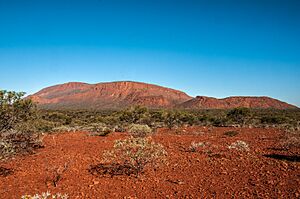Mount Augustus (Western Australia) facts for kids
Mount Augustus, known as Burringurrah by the local Wajarri people, is a massive rock formation in Western Australia. It is located about 1,000 kilometers (620 miles) north of Perth. The Wajarri people consider this place sacred and have many ancient Dreamtime stories about it. Mount Augustus is a very tall "island mountain," also called an inselberg. It rises about 860 meters (2,820 feet) above the flat land around it. The main part of the rock is almost 8 kilometers (5 miles) long!
Contents
Is Mount Augustus the World's Biggest Rock?
You might hear that Mount Augustus is the "world's largest monolith." A monolith is a single, huge piece of rock, like Uluru (Ayers Rock). However, Mount Augustus is actually an anticline. This means its rock layers have been folded into a giant arch shape.
How Mount Augustus Was Formed
Mount Augustus started forming about 1,600 million years ago. Sand and gravel were laid down by an ancient river. Over time, these layers turned into sandstone and conglomerate rock. Later, shallow seas covered the area, adding more layers of sediment. About 900 million years ago, the Earth's crust moved, causing these rock layers to buckle and fold into the arch shape we see today. Wind and water have slowly worn away the softer rocks, revealing the hard core of Mount Augustus.
Gold Rush History
In the 1890s, people rushed to the Mount Augustus area because gold was discovered there. This was an exciting time for the region!
Plants and Animals of Mount Augustus
Mount Augustus is home to many different plants and animals.
What Plants Grow Here?
The main plants you'll see are different kinds of wattles, cassias, and eremophilas. These plants are well-suited to the dry conditions.
What Animals Live Here?
You can find many animals, including emus, red kangaroos, goannas, and euros. There are also over 100 different types of birds, especially birds of prey, that live on and around Mount Augustus.
Exploring Mount Augustus: Walking Trails
Mount Augustus has several walking trails for visitors to explore.
Climbing to the Summit
If you want to reach the top, there are two main trails. Climbing to the summit and back can take up to 5 hours. It's important to be prepared for the climb.
Safety on the Trails
It's very important to be careful when walking on the trails, especially the summit trail. During the hottest months, from September to March, it can be very dangerous due to extreme heat. Authorities suggest closing the summit trail during this time to keep hikers safe. Always carry plenty of water and be aware of the weather.
Aboriginal History and Rock Art
Mount Augustus has a rich history for the local Wajarri Aboriginal people.
Ancient Rock Engravings
You can see evidence of early Aboriginal life in the amazing rock engravings found around Mount Augustus. These engravings tell many of the Wajarri people's Dreamtime stories. You can find these special sites, like Mundee, Ooramboo, and Beedoboondu, along the loop walking trail. They offer a glimpse into thousands of years of history and culture.
See also
 In Spanish: Monte Augustos para niños
In Spanish: Monte Augustos para niños


